A Novel Iterative Discrete Estimation Algorithm for Low-Complexity Signal Detection in Uplink Massive MIMO Systems
Abstract
:1. Introduction
2. System Model
3. Proposed MIDE Algorithm
3.1. ML Problem Formulation and IDE-Based Algorithm
3.2. Modified IDE-Based Detection Algorithm with Self-Update Damping
| Algorithm 1: The pseudocode of the MIDE detection algorithm. |
| 1 Input: 1) , the channel matrix 2 2) , the received signal matrix 3 3) K, the number of iterations 4 Output: the detected signal 5 Preprocessing
|
3.3. Analysis of the Complexity of the Algorithm
- (1)
- Preprocess: The first part comes from the related computation before the iterative process. The main factors affecting the computational complexity of the preprocess are the computation of and the multiplication of the diagonal matrix and the matrix. Let be the column of the complex-valued channel matrix . Then, the diagonal calculation can be presented as:Therefore, the complexity of the preprocessing is counted as .
- (2)
- -update procedure: The second part comes from the x-update procedure, which involves the computation of two multiplications of the matrix and the vector. Thus, the complexity is counted as .
- (3)
- -update procedure: The third part originates from updating the value of . As can be seen in the expression of , the computation of this part includes the update of the Euclidean distance and two scalar multiplications with vectors. Then, the complexity in this part is counted as .
4. Simulation Results
4.1. BER Performance Evaluation
4.2. Computational Complexity Comparison
5. Conclusions
Author Contributions
Funding
Conflicts of Interest
References
- Xiang, W.; Zheng, K.; Shen, X.S. 5G Mobile Communications; Springer International Publishing: Basel, Switzerland, 2017. [Google Scholar]
- Lu, L.; Li, G.Y.A.; Swindlehurst, L.; Ashikhmin, A.; Zhang, R. An overview of massive MIMO: Benefits and challenges. IEEE J. Sel. Topics Signal Process. 2014, 8, 742–758. [Google Scholar] [CrossRef]
- Wu, M.; Yin, B.; Wang, G.; Dick, C.; Cavallaro, J.R.; Studer, C. Large-scale MIMO detection for 3GPP LTE: algorithms and FPGA implementations. IEEE J. Sel. Topics Signal Process. 2014, 8, 916–929. [Google Scholar] [CrossRef]
- Ngo, H.; Larsson, E.; Marzetta, T. Energy and spectral efficiency of very large multiuser MIMO systems. IEEE Trans. Commun. 2012, 61, 1436–1449. [Google Scholar]
- Rusek, F.; Persson, D.; Lau, B.K.; Larsson, E.G.; Marzetta, T.L.; Edfors, O.; Tufvesson, F. Scaling up MIMO: Opportunities and challenges with very large arrays. IEEE Signal Process. Mag. 2013, 30, 40–60. [Google Scholar] [CrossRef]
- Chockalingam, A.; Rajan, B.S. Large MIMO Systems; Cambridge University Press: Cambridge, UK, 2014. [Google Scholar]
- Kuchi, K.; Ayyar, A.B. Performance analysis of ML detection in MIMO systems with co-channel interference. IEEE Commun. Lett. 2011, 15, 786–788. [Google Scholar] [CrossRef]
- Mandloi, M.; Bhatia, V. Low-complexity near-optimal iterative sequential detection for uplink massive MIMO systems. IEEE Commun. Lett. 2017, 21, 568–571. [Google Scholar] [CrossRef]
- Gustafsson, O.; Bertilsson, E.; Klasson, J.; Ingemarsson, C. Approximate Neumann Series or exact matrix inversion for massive MIMO? In Proceedings of the 2017 IEEE 24th Symposium on Computer Arithmetic (ARITH), London, UK, 24–26 July 2017. [Google Scholar]
- Fang, L.; Huang, D. Neumann Series Expansion Based LMMSE Channel Estimation for OFDM Systems. IEEE Commun. Lett. 2016, 20, 748–751. [Google Scholar] [CrossRef]
- Gao, X.; Dai, L.; Ma, Y.; Wang, Z. Low-complexity near-optimalsignal detection for uplink large-scale MIMO systems. Electron. Lett. 2014, 50, 1326–1328. [Google Scholar] [CrossRef]
- Qin, X.; Yan, Z.; He, G. A near-optimal detection scheme based on joint steepest descent and Jacobi method for uplink massive MIMO systems. IEEE Commun. Lett. 2016, 20, 276–279. [Google Scholar] [CrossRef]
- Lee, Y. Decision-aided Jacobi iteration for signal detection in massive MIMO systems. Electron. Lett. 2017, 53, 1552–1554. [Google Scholar] [CrossRef]
- Kong, B.Y.; Park, I. Low-complexity symbol detection for massive MIMO uplink based on Jacobi method. In Proceedings of the IEEE 27th Annual International Symposium on Personal, Indoor, and Mobile Radio Communications (PIMRC), Valencia, Spain, 1–5 September 2016. [Google Scholar]
- Minango, J.; de Almeida, C.; Daniel Altamirano, C. Low-complexity MMSE detector for massive MIMO systems based on Damped Jacobi method. In Proceedings of the 2017 IEEE 28th Annual International Symposium on Personal, Indoor, and Mobile Radio Communications (PIMRC), Montreal, QC, Canada, 1–5 October 2017. [Google Scholar]
- Deng, Q.; Guo, L.; Dong, C.; Lin, J.; Meng, D.; Chen, X. High-throughput signal detection based on fast matrix inversion updates for uplink massive multiuser multiple-input multi-output systems. IET Commun. 2017, 11, 2228–2235. [Google Scholar] [CrossRef]
- Sun, Y.; Li, Z.; Zhang, C.; Zhang, R.; Yan, F.; Shen, L. Low complexity signal detector based on SSOR iteration for large-scale MIMO systems. In Proceedings of the 9th International Conference on Wireless Communications and Signal Processing (WCSP), Nanjing, China, 1–6 October 2017. [Google Scholar]
- Dai, L.; Gao, X.; Su, X.; Han, S.; Chih-Lin, I.; Wang, Z. Low-complexity soft-output signal detection based on Gauss–Seidel method for uplink multiuser large-scale MIMO systems. IEEE Trans. Veh. Technol. 2015, 64, 4839–4845. [Google Scholar] [CrossRef]
- Zeng, J.; Lin, J.; Wang, Z. An improved Gauss–Seidel algorithm and its efficient architecture for massive MIMO systems. IEEE Trans. Circuits Syst. II-Express Briefs. 2018, 65, 1194–1198. [Google Scholar] [CrossRef]
- Elgabli, A.; Elghariani, A.; Aggarwal, V.; Bell, M.R. A low-complexity detection algorithm for uplink massive MIMO systems based on Alternating Minimization. IEEE Wirel. Commun. Lett. 2019, 8, 917–920. [Google Scholar] [CrossRef]
- Souto, N.; Dinis, R. MIMO detection and equalization for single-carrier systems using the Alternating Direction Method of Multipliers. IEEE Signal Process. Lett. 2016, 23, 1751–1755. [Google Scholar] [CrossRef]
- Shahabuddin, S.; Juntti, M.; Studer, C. Admm-based infinity normdetection for large MU-MIMO: Algorithm and vlsi architecture. In In Proceedings of the IEEE International Symposium on Circuits and Systems (ISCAS), Baltimore, MD, USA, 1–4 May 2017. [Google Scholar]
- Zhang, K.; Zhang, Y. Recursive algorithm for calculating eigenvalues of real symmetric matrix based on LDLT decomposition. Computer Engineering and Applications. 2008, 44, 78–80. [Google Scholar]
- Chou, C.; Wu, J. Low-complexity MIMO precoder design with LDLH channel decomposition. IEEE Trans. Veh. Technol. 2011, 60, 2368–2372. [Google Scholar] [CrossRef]
- Wang, C.; Wen, C.; Jin, S.; Tsai, S. Finite-Alphabet precoding for massive MU-MIMO with low-resolution DACs. IEEE Trans. Wirel. Commun. 2018, 17, 4706–4720. [Google Scholar] [CrossRef]
- Chen, J. A low complexity data detection algorithm for uplink multiuser massive MIMO systems. IEEE J. Sel. Areas Commun. 2017, 35, 1701–1714. [Google Scholar] [CrossRef]
- Jin, F.; Liu, Q.; Liu, H.; Wu, P. A low complexity signal detection scheme based on improved Newton iteration for massive MIMO systems. IEEE Commun. Lett. 2019, 23, 748–751. [Google Scholar] [CrossRef]
- Wu, Z.; Ge, L.; You, X.; Zhang, C. Efficient near-MMSE detector for large-scale MIMO systems. In In Proceedings of the 2017 IEEE International Workshop on Signal Processing Systems (SiPS), Lorient, France, 1–6 October 2017. [Google Scholar]
- Wu, C.; Huang, W.; Chung, W. Robust update algorithms for Zero-Forcing detection in uplink large-scale MIMO systems. IEEE Commun. Lett. 2018, 22, 424–427. [Google Scholar] [CrossRef]
- Monteiro, F.A.; Wassell, I.J. Euclidean distances in quantized spaces with pre-stored components for MIMO detection. In In Proceedings of the European Conference on Wireless Technologies, Munich, Germany, 8–10 October 2007. [Google Scholar]
- Hunger, R. Floating Point Operations in Matrix-Vector Calculus; Technical Report; Munich University of Technology: Munich, Germany, 2007. [Google Scholar]
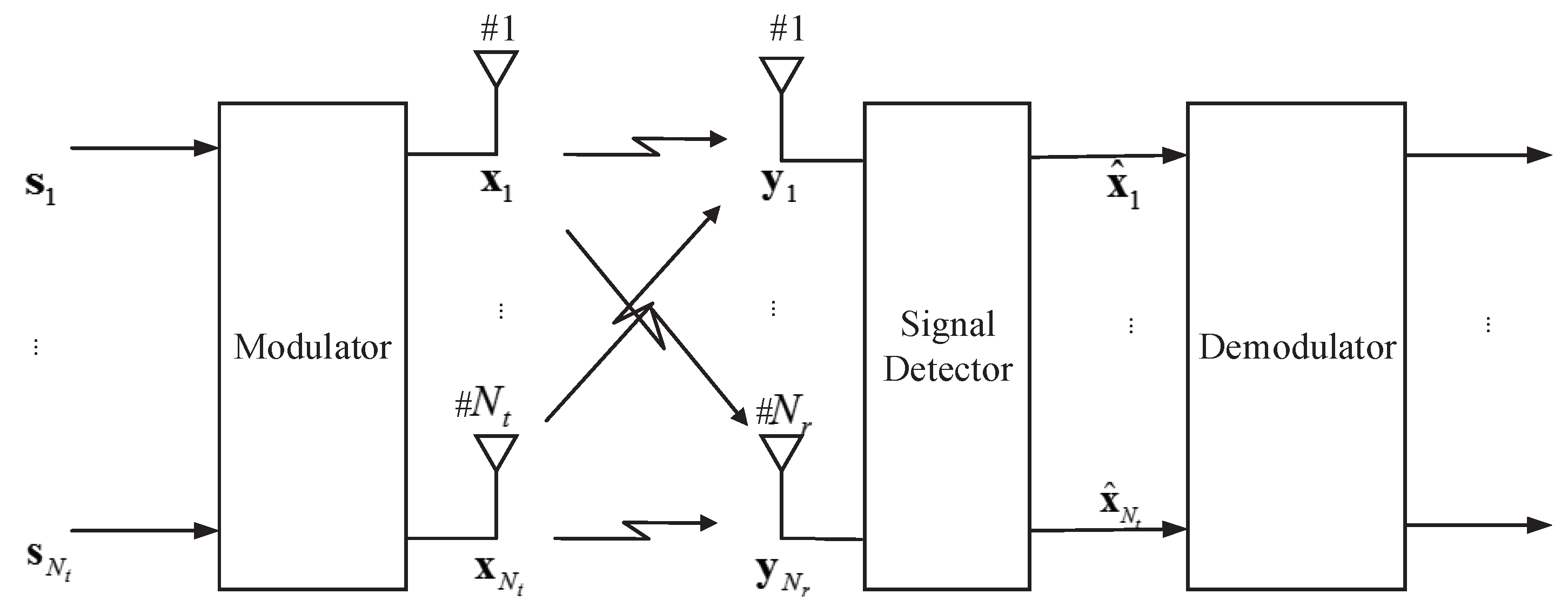
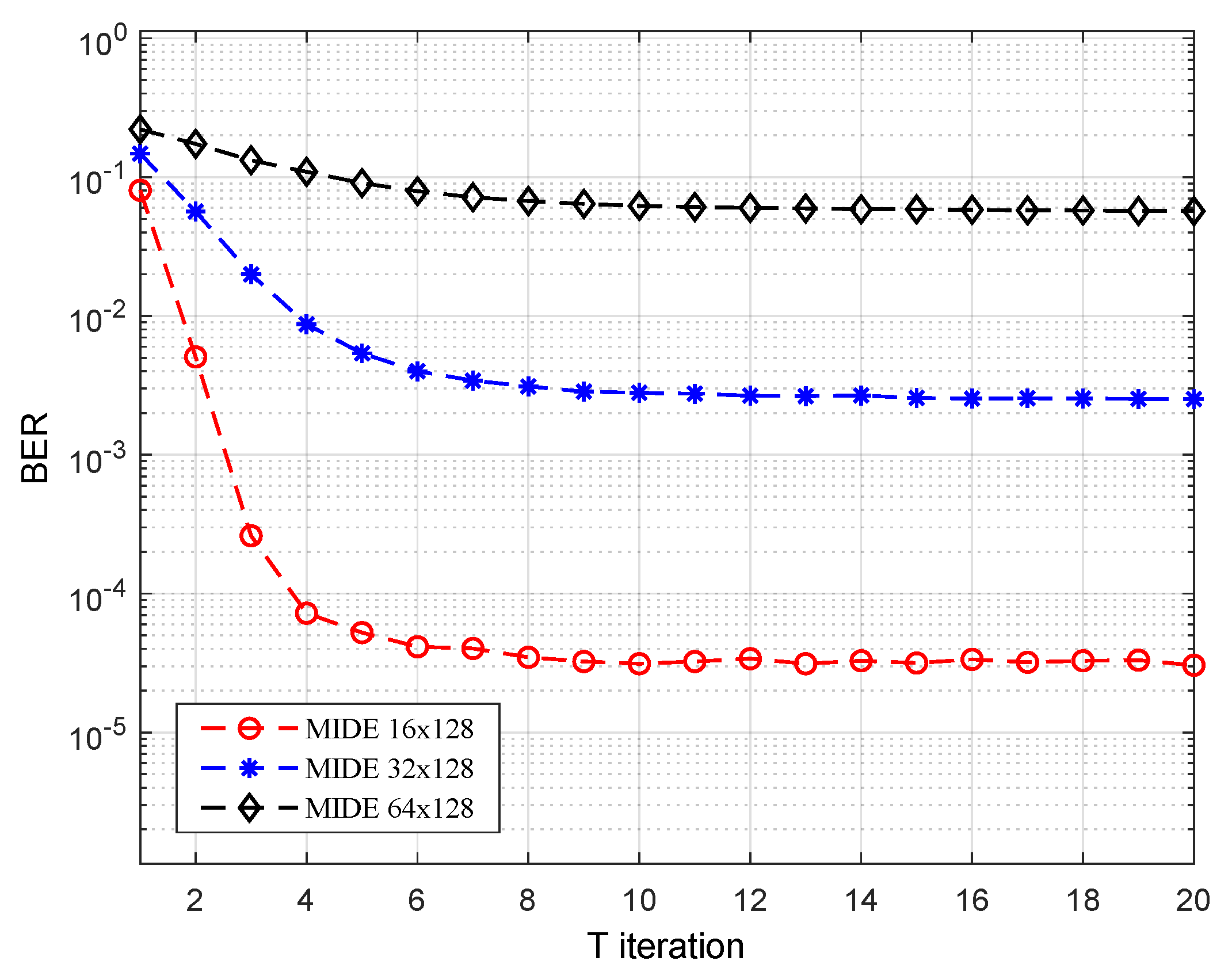
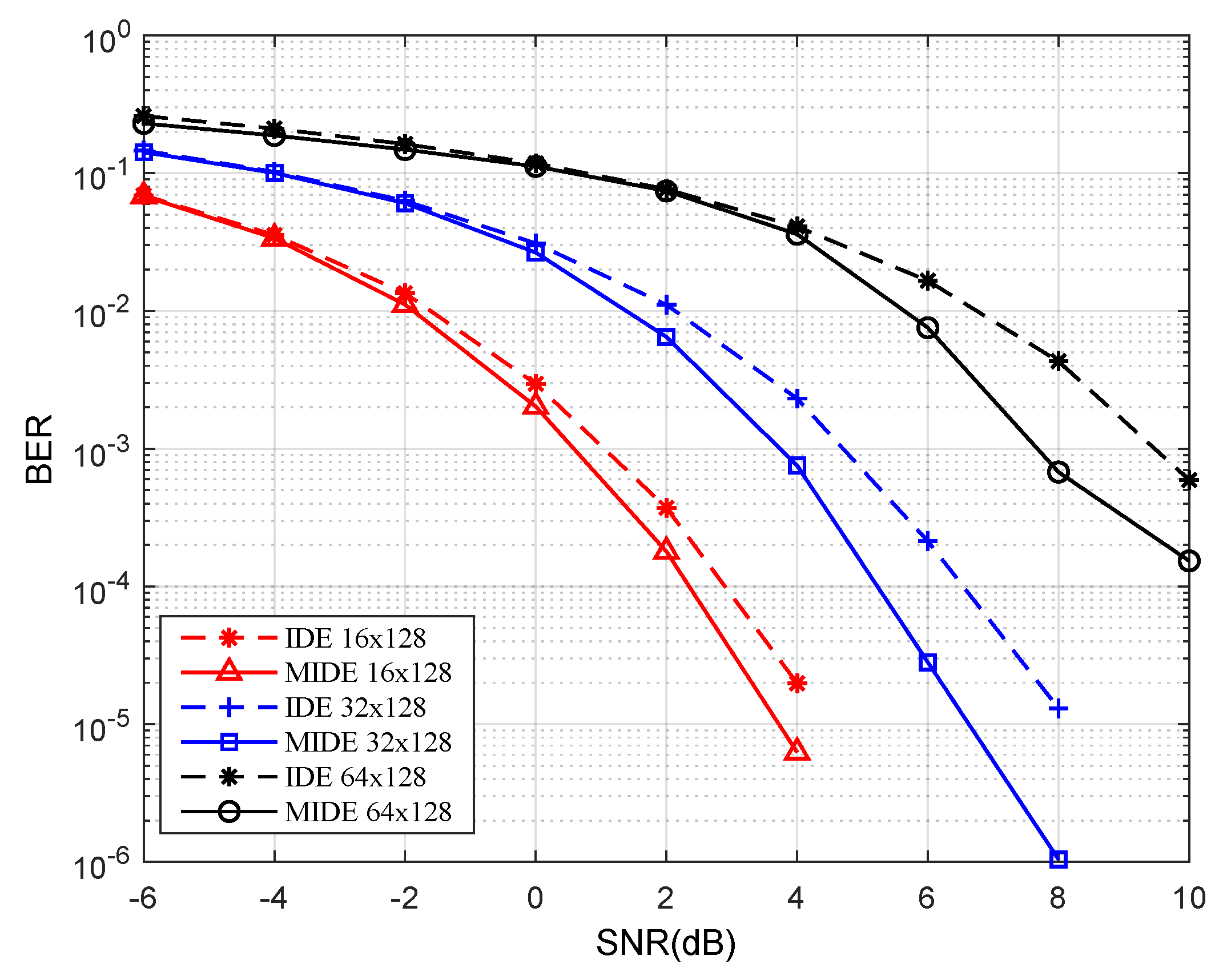
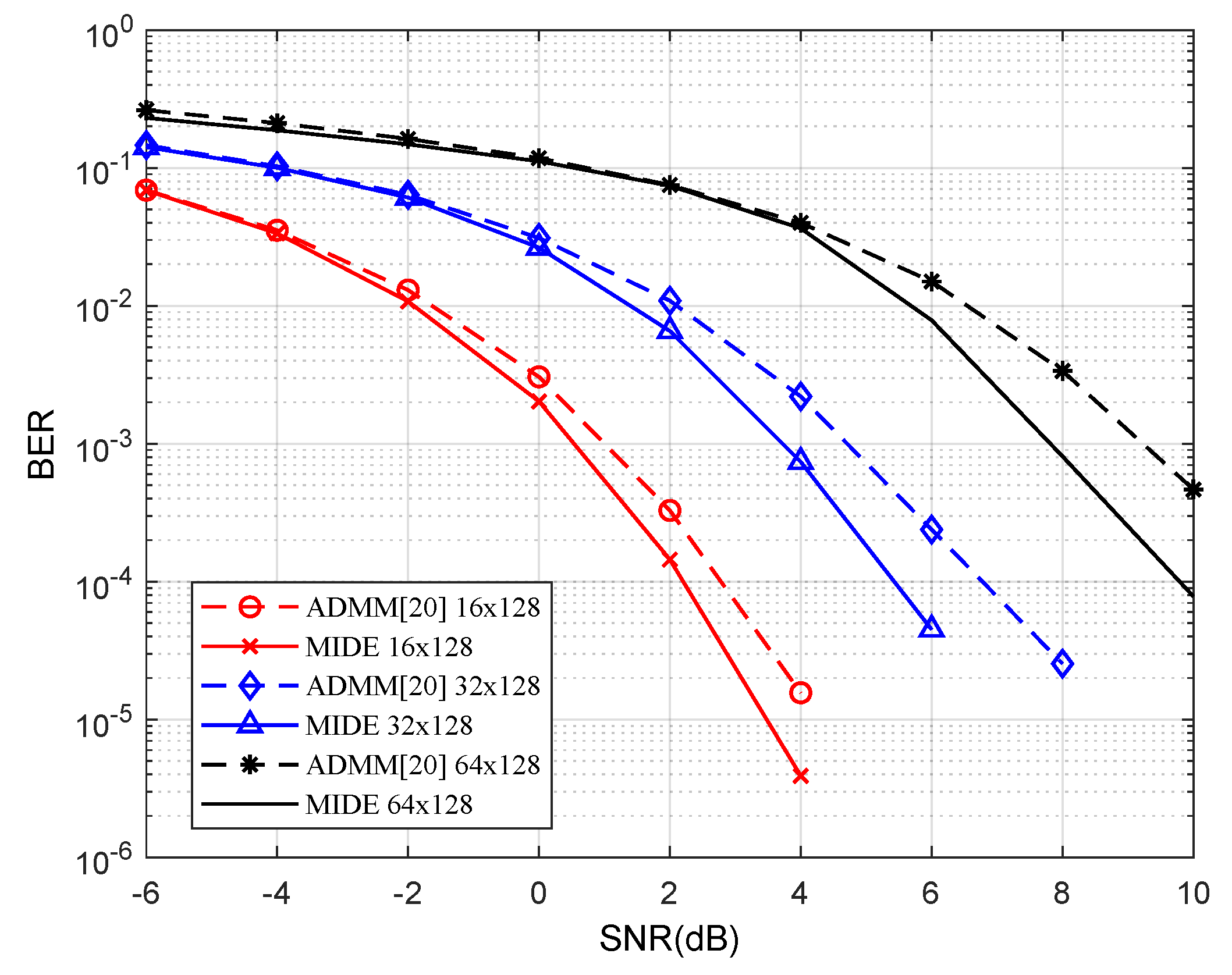
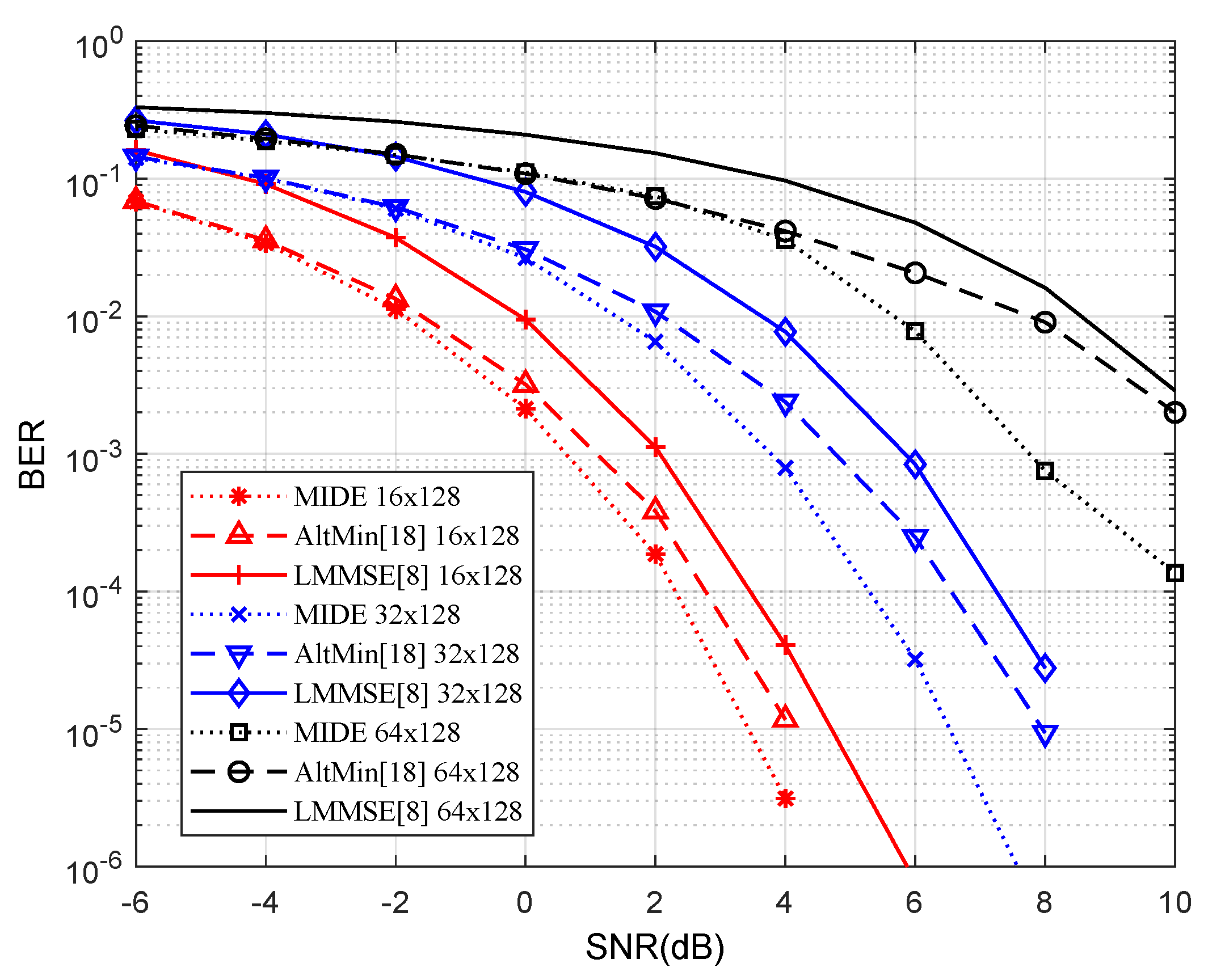
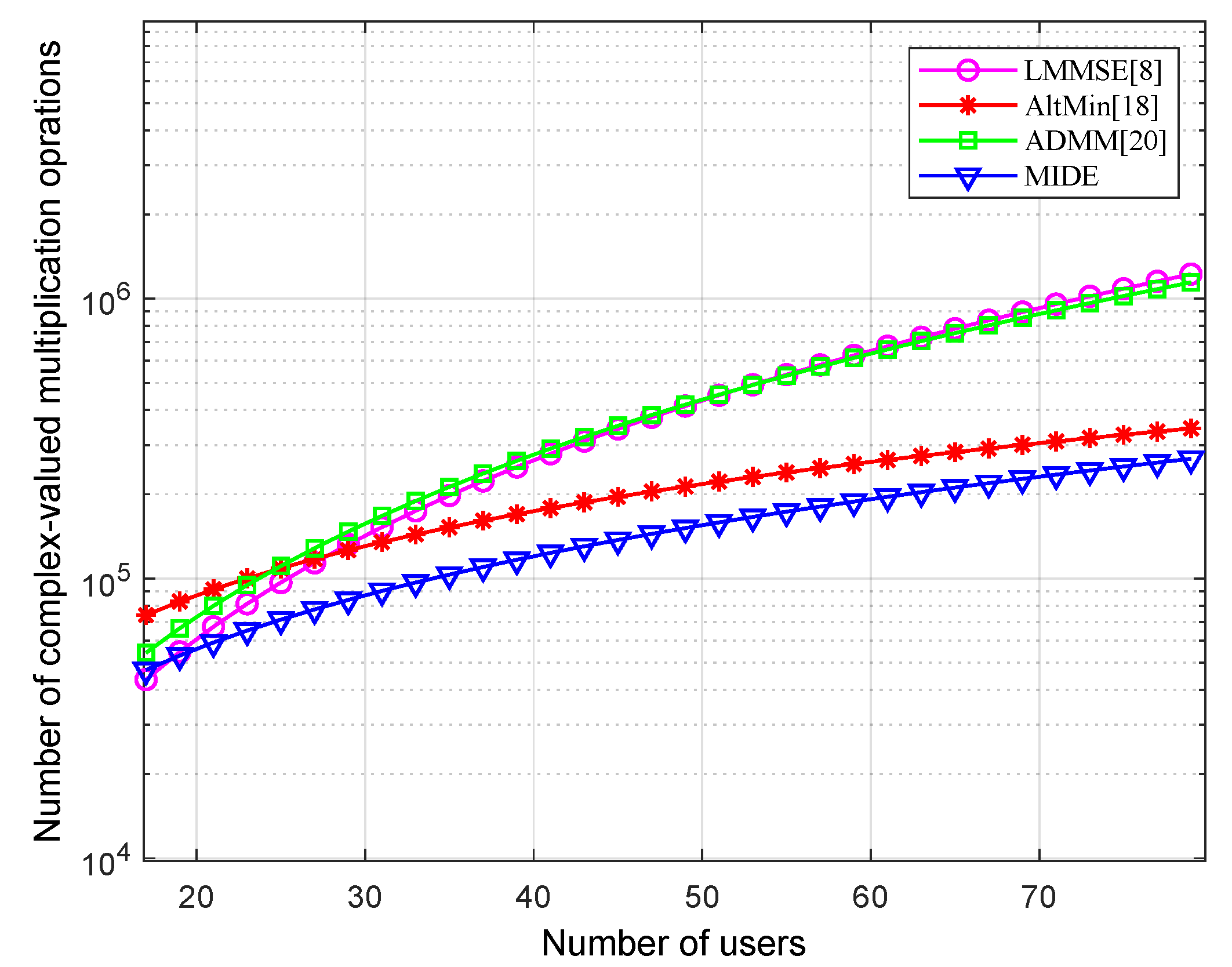
| Algorithm | Complexity |
|---|---|
| LMMSE [8] | |
| AltMin [18] | |
| ADMM [20] | |
| MIDE |
| Channel Model | Uncorrelated Rayleigh Flat Fading |
|---|---|
| Modulation scheme | 16-QAM |
| Number of transmitting antennas () | 16, 32, 64 |
| Number of receiving antennas () | 128 |
© 2019 by the authors. Licensee MDPI, Basel, Switzerland. This article is an open access article distributed under the terms and conditions of the Creative Commons Attribution (CC BY) license (http://creativecommons.org/licenses/by/4.0/).
Share and Cite
Feng, H.; Zhao, X.; Li, Z.; Xing, S. A Novel Iterative Discrete Estimation Algorithm for Low-Complexity Signal Detection in Uplink Massive MIMO Systems. Electronics 2019, 8, 980. https://doi.org/10.3390/electronics8090980
Feng H, Zhao X, Li Z, Xing S. A Novel Iterative Discrete Estimation Algorithm for Low-Complexity Signal Detection in Uplink Massive MIMO Systems. Electronics. 2019; 8(9):980. https://doi.org/10.3390/electronics8090980
Chicago/Turabian StyleFeng, Hui, Xiaoqing Zhao, Zhengquan Li, and Song Xing. 2019. "A Novel Iterative Discrete Estimation Algorithm for Low-Complexity Signal Detection in Uplink Massive MIMO Systems" Electronics 8, no. 9: 980. https://doi.org/10.3390/electronics8090980
APA StyleFeng, H., Zhao, X., Li, Z., & Xing, S. (2019). A Novel Iterative Discrete Estimation Algorithm for Low-Complexity Signal Detection in Uplink Massive MIMO Systems. Electronics, 8(9), 980. https://doi.org/10.3390/electronics8090980





